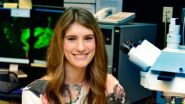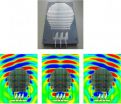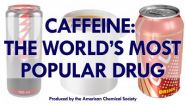(Press-News.org) AUGUSTA, Ga. –A class of drugs widely used to treat osteoporosis appears to impede a cell's ability to repair a protective outer membrane that helps determine what enters and exits, researchers report.
The inability to quickly repair a membrane is lethal to a cell and may help explain the rare and serious side effect of jawbone destruction that can occur following dental work in patients taking these drugs, said Caroline Lewis, a sophomore at the Medical College of Georgia at Georgia Regents University.
"The bottom line is it inhibits cell membrane repair in two distinct cell types," Lewis said. She is among five winners of the 2014 National Medical Students Competition of the American College of Physicians. Lewis presented her work April 12 during the college's Internal Medicine 2014 meeting in Orlando.
Working in the lab of Dr. Paul McNeil, an MCG cell biologist specializing in cell membrane repair, Lewis found that kidney epithelial cells from monkeys and muscle cells from mice both lost their ability to quickly repair their outer membrane after exposure to zoledronate, a commonly used bisphosphonate, Lewis said. Without drug exposure, cells quickly recovered from a microscope laser injury.
"That is healthy, normal repair," she said, citing a video showing the normal cell experiencing only a brief flicker of fluorescence where hit by a laser. On the other hand, zoledronate-exposed cells quickly filled with a fluorescent dye the researchers placed in the petry dish.
"All this dye coming into the cell means there is still a disruption and no repair occurred to sort of mend the fence," Lewis said. "We know these cells are dying, Basically these videos speak for themselves."
"It's a paradox," added McNeil. "On the one hand, (the drug) is given to people mainly to promote bone health, increase bone density. But in the case of a jaw that has suffered, for example, a tooth extraction, the exact opposite occurs."
He theorized cell membrane repair was contributing to destruction of the jawbone and the lining of the mouth after a 2012 report in the Journal of Proteome Research that bisphosphonates bind to cell membrane proteins vital to membrane repair. Since the severe side effect seems to occur only following dental work, McNeil made the connection.
While it's not clear whether this failure to repair is happening in other parts of the body, McNeil and Lewis note that cell membrane repair is typically a constant throughout the body.
"Pretty much every day of our life, even exercising, you are contracting your muscles, the muscle cells rub past each other and that friction causes microscopic tears in the membrane," Lewis said. "If those cells can't repair an injury, they die because they can' t maintain internal homeostasis."
Next steps include more cell studies, including those on jawbone cells, McNeil said. Kidney epithelial cells and muscle cells used in this study are routinely used in cell membrane repair research, and cell repair mechanisms tend to be consistent across cell types, even across different species, McNeil noted.
He also is pursuing the potential protective properties of vitamin E for these patients. McNeil reported in December 2011 in the journal Nature Communications that vitamin E, a powerful antioxidant found in most foods, helps repair tears in the plasma membrane.
In the meantime, Lewis suggests that patients taking the drugs talk with their physicians if they have concerns. Some physicians and dentists recommend a drug holiday for these patients before having dental work.
Bisphosphonates are thought to work primarily by inhibiting bone-consuming cells called osteoclasts, which balance the activty of bone-producing osteoblasts, a balance that's lost in osteoporosis. Bisphosophonate-related osteonecrosis of the jaw, or BRON, is among a fairly long list of side effects for these drugs, including rashes swelling, upper chest pain, irregular heartbeat, and painful or swollen gums and loosening of the teeth, according to MedlinePlus Drug Information.
Bisphosphonates also are used to treat hypercalcemia, high blood levels of calcium that can result from cancer, an overactive parathyroid, and calcium supplements; as well as multiple myeloma, cancer of the plasma cells; and cancer that has spread to the bone.
Lewis, who is from Savannah, Ga., worked with McNeil last summer as a participant in the MCG Dean's Student Summer Research Program.
INFORMATION: END
Osteoporosis drugs appear to impede cell membrane repair
2014-04-14
ELSE PRESS RELEASES FROM THIS DATE:
Long-term antibiotic treatment for Q fever causes weight gain
2014-04-14
Scientists have unearthed still more evidence that antibiotics can contribute to obesity. Research published ahead of print in the journal Antimicrobial Agents and Chemotherapy suggests that patients on long-term antibiotic treatment gained weight and had significant changes in their gut microbiota.
The study, led by Didier Raoult, of Aix-Marseille University, Marseille, France, followed 48 patients who were being treated long-term with doxycycline and hydroxychloroquine for Q fever, and 34 control subjects. Nearly one quarter of the treated patients gained anywhere ...
Shiny quantum dots brighten future of solar cells
2014-04-14
A house window that doubles as a solar panel could be on the horizon, thanks to recent quantum-dot work by Los Alamos National Laboratory researchers in collaboration with scientists from University of Milano-Bicocca (UNIMIB), Italy. Their project demonstrates that superior light-emitting properties of quantum dots can be applied in solar energy by helping more efficiently harvest sunlight.
"The key accomplishment is the demonstration of large-area luminescent solar concentrators that use a new generation of specially engineered quantum dots," said lead researcher Victor ...
UT Dallas study: Youth who fail to envision future commit more crimes
2014-04-14
In a UT Dallas study involving serious youth offenders, the answer to one open-ended question predicted the teenagers' offending patterns for the next seven years: "How long do you think you'll live?"
According to the study, having little hope for the future encourages offending over time.
Author Dr. Alex Piquero said the study found those who don't view a very long life ahead of them offend at very high rates and commit more serious offenses, while those who believe they're going to die much later in life offend much less.
"In a lot of distressed communities and for ...
Device turns flat surface into spherical antenna
2014-04-14
WASHINGTON D.C., April 14, 2014 -- By depositing an array of tiny, metallic, U-shaped structures onto a dielectric material, a team of researchers in China has created a new artificial surface that can bend and focus electromagnetic waves the same way an antenna does.
This breakthrough, which the team is calling the first broadband transformation optics metasurface lens, may lead to the creation of new types of antennas that are flat, ultra low-profile or conformal to the shape of curved surfaces.
The new lens, described in AIP Publishing's journal Applied Physics Letters, ...
The science of caffeine, the world's most popular drug (video)
2014-04-14
WASHINGTON, April 14, 2014 — It seems there are new caffeine-infused products hitting the shelves every day. From energy drinks to gum and even jerky, our love affair with that little molecule shows no signs of slowing. In the American Chemical Society's (ACS') latest Reactions video, we look at the science behind the world's most popular drug, including why it keeps you awake and how much caffeine is too much. The video is available at http://youtu.be/YuJOhpNS0IY.
INFORMATION:
Subscribe to the series at Reactions YouTube, and follow us on Twitter @ACSreactions to be ...
Study gives high marks to NC Pre-K program
2014-04-14
Scientists from UNC's Frank Porter Graham Child Development Institute have released their new study of NC Pre-K, the state's program to prepare four-year-olds for success in kindergarten. According to FPG's report, students enrolled in NC Pre-K show significant gains across all areas of learning.
"Children are progressing at an even greater rate during their participation in NC Pre-K than expected for normal developmental growth," said senior scientist Ellen Peisner-Feinberg, who leads the FPG team that has studied the program and provided it with recommendations for ...
Low birth weight, less breastfeeding create later health risks
2014-04-14
Lower weight babies and babies who aren't breastfed or not breastfed for long are at greater risk of developing chronic inflammation and related health problems later in life, according to a new study.
"There were good reasons to hypothesize that breastfeeding was important to influencing levels of inflammation in adulthood," says Thomas McDade (Northwestern University), a CIFAR (Canadian Institute for Advanced Research) Fellow in the Child & Brain Development program. "It changes the microbiome. It promotes development of the immune system. Children who are breastfed ...
Antibiotics alone are a successful treatment for uncomplicated acute appendicitis in kids
2014-04-14
Using antibiotics alone to treat children with uncomplicated acute appendicitis is a reasonable alternative to surgery that leads to less pain and fewer missed school days, according to a pilot study. The research, led by a team at Nationwide Children's Hospital and published online April 12 in the Journal of the American College of Surgeons, is the first prospective study on nonoperative management of acute appendicitis in pediatric patients in the United States.
Researchers enrolled 77 patients age 7 to 17 who were diagnosed with uncomplicated acute appendicitis by ...
Irrational health beliefs linked to skipping cardiac rehab sessions
2014-04-14
COLUMBUS, Ohio – Heart patients with beliefs about health that aren't based on medical evidence are more likely to skip sessions of cardiac rehabilitation, new research suggests.
In the Ohio State University study, a higher number of these beliefs – referred to as "irrational health beliefs" on a standard measure of these thoughts – was associated with lower adherence to a prescribed cardiac rehab program.
Among the irrational beliefs assessed: Doubting the preventive power of the flu vaccine or believing, based on family history alone, that it's safe to smoke cigarettes ...
Three new species of yellow-shouldered bats discovered in museum collections
2014-04-14
Scientists at Chicago's Field Museum and international collaborators have reconstructed the phylogeny and biological history for the Yellow-shouldered bats in the New World tropics, the region of the Earth surrounding the equator. In-depth analysis of mitochondrial and nuclear DNA sequences uncovered three species new to science, each having previously been confused with another species. Since 1960, when modern studies on this group began, Sturnira has grown from eight species to 22. The newest additions were described in a new study, published online in ZooKeys.
The ...





